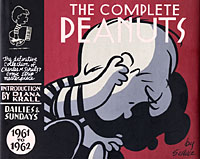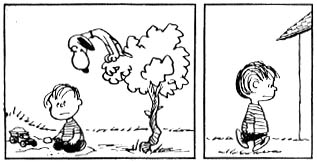 By Charles M. Schulz
By Charles M. Schulz
342 pages, black and white
Published by Fantagraphics Books
When I was a little kid, I used to regularly scour my library for collections of Charles M. Schulz’s Peanuts. The books would always be ragged and dog-eared, which if anything was a sign that I was hardly the only one reading them over and over again. So when Fantagraphics began their Complete Peanuts line a few years ago, I was over the moon. Reading the comic strips from the 1950s was a real thrill, with so many of them rarely or never reprinted, and even more of them new to me. Now that I’ve finally hit the 1960s strips, though, I can’t help but feel that I’ve entered the real Golden Age of Peanuts.
So many of the real classic moments and characters of Peanuts are in these strips: Snoopy as a vulture, Schroeder’s obsession with Beethoven, Lucy’s attempts to get rid of Linus’s blanket, Linus’s infatuation with his teacher Miss Othmar, and attempts to see the Great Pumpkin on Halloween. Even better, this is where some hallmarks of the strip first debut, like Lucy’s psychiatry booth, Sally shifting from infant to someone old enough to attend school, or Snoopy’s hanging out with birds (which would eventually evolve into the appearance of Woodstock years down the line).

What’s fun to see is how Schulz plays with the structure of writing a daily comic strip. Some strips are one-off jokes, going for the immediate punch line and then moving on. Others are a continuing story over a week or two, like Linus betting his blanket that Miss Othmar can’t stop biting her nails, or Lucy trying to "stomp out" the common cold. What I was a little surprised to see, though, was irregularly appearing ongoing stories. In the early 1961 strips, for example, every week had one or two strips about Snoopy’s doghouse being used as a meeting place for birds to hang out. As the strips progress, though, Snoopy seems more and more irritated by them until one week, with no warning, he kicks them all out. It’s the sort of thing that in the collected format is fun to see unfold, perhaps because it wasn’t an "every strip all in a row" sequence that most ongoing strips use.
 If I had to pick a character that really shines in The Complete Peanuts 1961-1962, it would have to be Linus. He really gets the bulk of the meaty stories, perhaps in part because instead of Charlie Brown’s affable everyman loser character, Linus is a general competent character with certain quirks. Obviously, his reliance on his security blanket is the most notable (and memorable) one, and Schulz uses it to great effect. From Lucy hiding and burying the blanket, to it being turned into a kite that blows away, Linus’s love for and dependence on the blanket never fails to both amuse and sadden, here. It’s hard to not feel bad for Linus’s distraught reaction to losing his blanket, even as you secretly hope that the theme is revisited again down the road. There’s a lot more to Linus’s character here, though; my favorite is the return of his crush Miss Othmar, who had previously broken his heart by leaving to get married. When Linus first starts talking about her return, Charlie Brown asks, "I thought her name was Mrs. Hagemeyer now…" Linus’s response of, "No, that’s just her married name… in real life she’s Miss Othmar!" is telling, both in how children view their teachers as something much loftier than regular people, as well as his (unstated) denial about her being married and somehow still his special teacher. Linus’s crisis of faith when he hears that teachers are paid to do their jobs—and thus Miss Othmar is being paid to be his teacher—is a real classic of this series, showing just how perfectly Schulz understood the psyche of a child and how a crush on an authority figure can blossom. Even tiny storylines, like Linus having to get glasses, or his battles with Lucy, come across in such a way that it’s easy to see how Linus grew into one of the real central figures of the strip.
If I had to pick a character that really shines in The Complete Peanuts 1961-1962, it would have to be Linus. He really gets the bulk of the meaty stories, perhaps in part because instead of Charlie Brown’s affable everyman loser character, Linus is a general competent character with certain quirks. Obviously, his reliance on his security blanket is the most notable (and memorable) one, and Schulz uses it to great effect. From Lucy hiding and burying the blanket, to it being turned into a kite that blows away, Linus’s love for and dependence on the blanket never fails to both amuse and sadden, here. It’s hard to not feel bad for Linus’s distraught reaction to losing his blanket, even as you secretly hope that the theme is revisited again down the road. There’s a lot more to Linus’s character here, though; my favorite is the return of his crush Miss Othmar, who had previously broken his heart by leaving to get married. When Linus first starts talking about her return, Charlie Brown asks, "I thought her name was Mrs. Hagemeyer now…" Linus’s response of, "No, that’s just her married name… in real life she’s Miss Othmar!" is telling, both in how children view their teachers as something much loftier than regular people, as well as his (unstated) denial about her being married and somehow still his special teacher. Linus’s crisis of faith when he hears that teachers are paid to do their jobs—and thus Miss Othmar is being paid to be his teacher—is a real classic of this series, showing just how perfectly Schulz understood the psyche of a child and how a crush on an authority figure can blossom. Even tiny storylines, like Linus having to get glasses, or his battles with Lucy, come across in such a way that it’s easy to see how Linus grew into one of the real central figures of the strip.
There’s a lot of great moments in this Complete Peanuts volumes, like the introduction of Frieda with her naturally curly hair, and who serves as a much better continual foil for the other characters than the short-lived Charlotte Braun ever did. While her naturally floppy cat never achieved quite the same iconic status, it still serves as a great contrast for the overly active Snoopy. And of course, Charlie Brown’s perpetually losing baseball team is one of the great ongoing stories of comic strips. If you’ve only ever read Peanuts strips from the ’90s, you have no idea how strong this strip was back in the day. I’ve got several additional ’60s collections waiting to be read, and I can’t wait to dive into the next volume.
Purchase Link: Amazon.com
